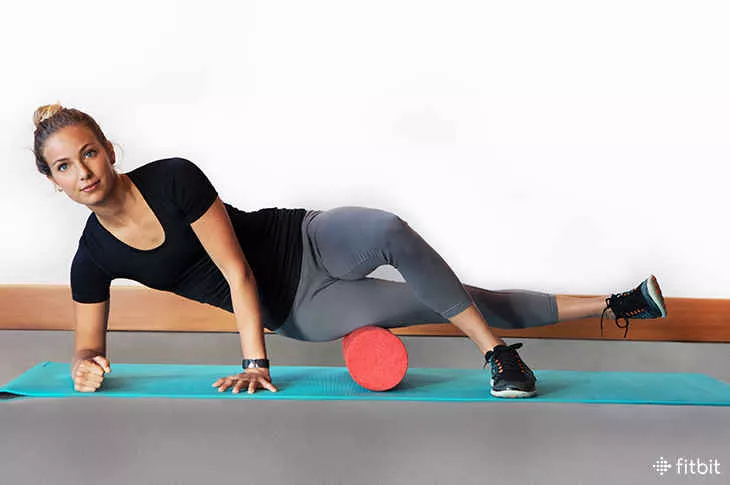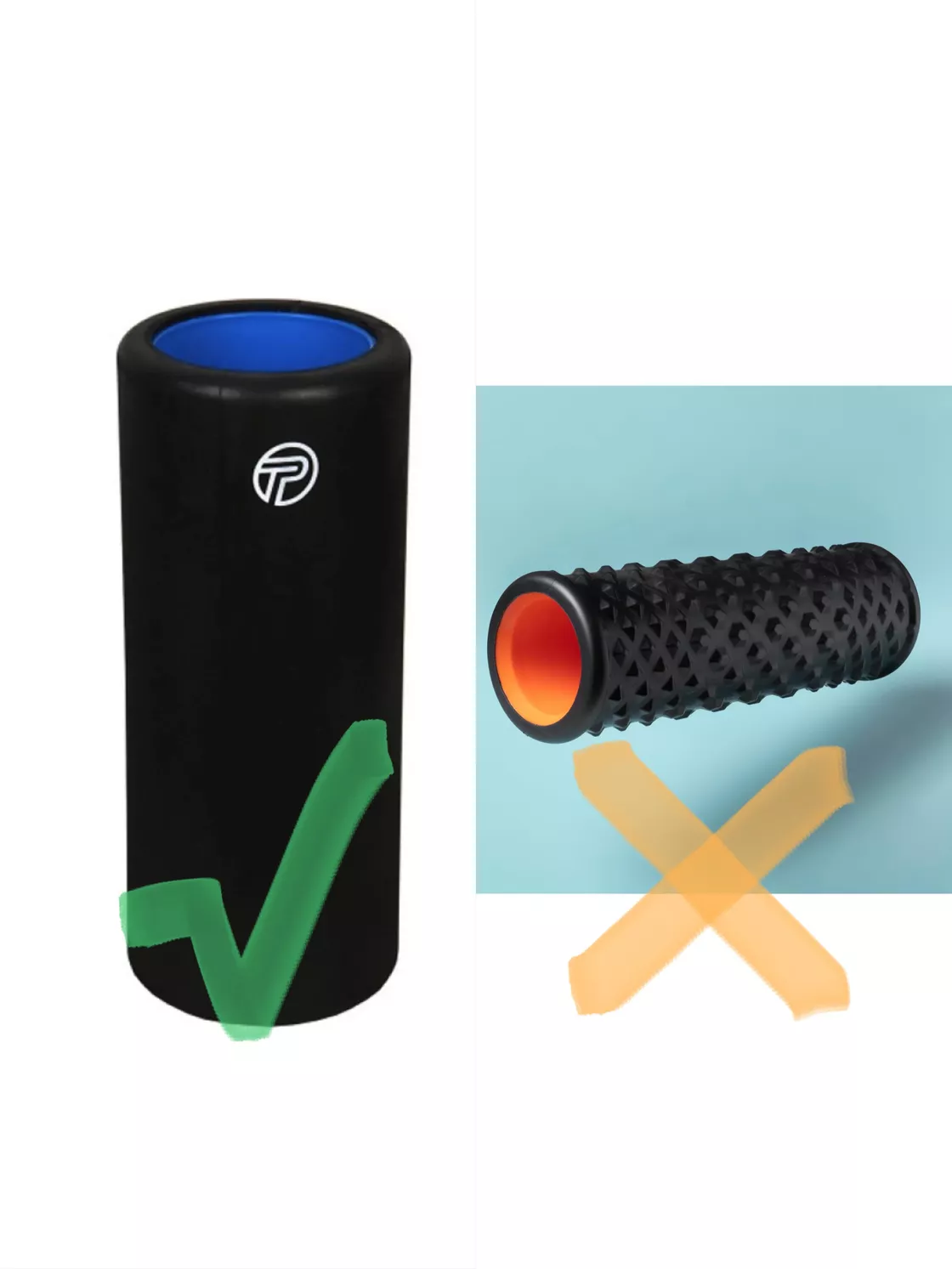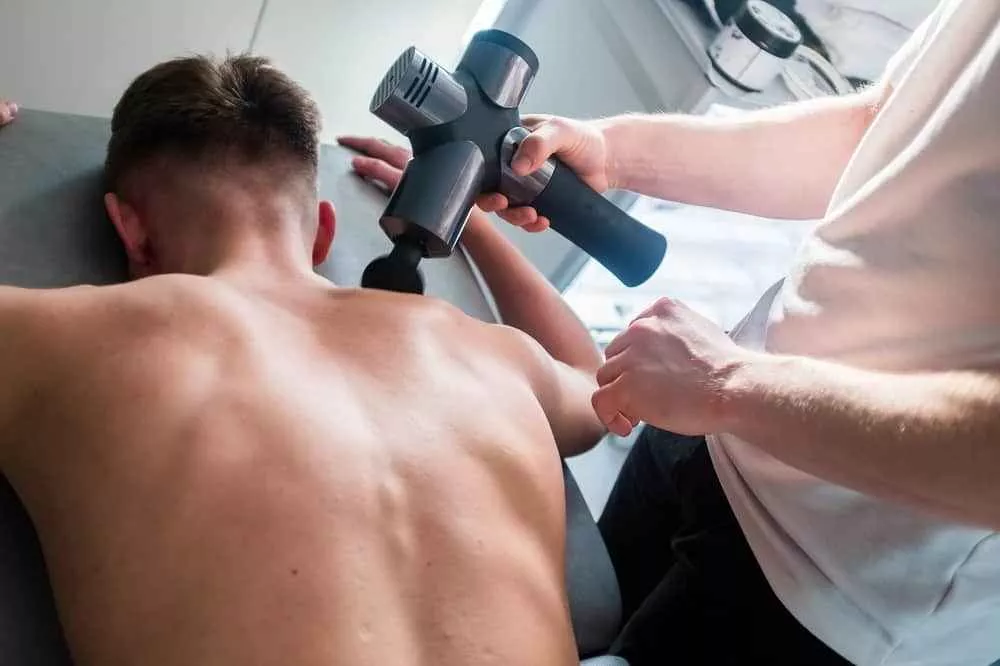As a new generation of netflix exercise product, fascia gun has become a must-have tool for almost every household. Not only are celebrity idols promoting it in various programs, but businesses will take "active muscle groups, dredge meridians, massage and slim legs" and other functions to promote it.
But are fascia guns really that amazing? Or is it simply an IQ tax?
Myofascial and fascial release
The fascial gun, as you know from its naming, has a function closely related to fascia, so we first need to understand what fascia is.
The soft tissue component of connective tissue is called fascia, and fascial tissue is described as a bundled, indivisible network of connective tissue around muscles and organs in the body.
In simple terms, think of fascia as layer after layer of cling film covering all the muscles, ligaments, tendons and even joints. The white, mucous-like layer on the surface of the chicken breast is known as fascia.

Schematic diagram of fascia, image from the internet Fascia can become tight or inflamed due to factors such as poor posture, dehydration, injury, stress and lack of exercise . When fascial tissues are tight or inflamed, this can lead to reduced joint range of motion, muscle strength and soft tissue extension, and sometimes, pain (e.g., plantar fasciitis).
Performing myofascial relaxation helps to reduce tightness and inflammation of the fascia, most myofascial relaxation techniques focus on the concept of relaxation by applying pressure to stimulate the muscle to become tighter, thus stimulating the tendon spindle to produce autoinhibition, reducing the excitability of the spindle and relaxing the overly tense muscle, thus improving tightness and inflammation of the fascia.
myosin: an intra-muscular receptor that is aligned parallel to the muscle fibers and is sensitive to changes in muscle length and the rate of length change. When a muscle is stretched, the sarcomere is also activated by elongation, reflexively causing the muscle to contract, the detrusor reflex, for example the knee jerk reflex is a detrusor reflex.
Tendon shuttle: a receptor at the articulation of muscle fibers with tendons, arranged in tandem with muscle fibers and sensitive to changes in muscle tone and the rate of change in tone. An increase in muscle tension activates the tendon shuttle, reflexively causing the muscle to relax. When a muscle stimulates the tendon shuttle in response to an increase in its own tone and thus reflexively causes its own relaxation, it is called autoinhibition.
There are three main types of myofascial release: direct myofascial relaxation, indirect myofascial relaxation, and self-myofascial relaxation.
Direct myofascial relaxation, usually acting directly on the area of restricted fascia. Usually using fists, knuckles, elbows and other tools to slowly sink into the tight fascia, applying a few kilograms of pressure to try to stretch the fascia, as in usual pushing, massage, etc.
Indirect Myofascial Relaxation, refers to the gentle stretching of tight areas of fascia. Studies have found that applying gentle traction to tight fascia will transfer heat while increasing blood flow to the target area, as in static stretching.
Self-myofascial relaxation involves applying pressure with your own body weight on a soft object for myofascial relaxation. Often tools such as soft foam shafts or tennis balls are used, and the body is placed over these tools, and then the force of gravity is used to apply pressure to specific muscle groups for myofascial relaxation.
Myofascial guns (massage guns) and vibrating foam shafts are new tools that have been developed to better help people with self-myofascial relaxation, and the developers this believe that these new tools can provide similar benefits to traditional self-myofascial relaxation techniques, but does it really work?
The role of the fascia gun
According to the official website of DMS USA, the working principle and function of the fascia gun is as follows.
The Fascial Gun produces a rapid succession of vibrations and blows that affect the function of the mechanoreceptors (muscle and tendon shuttles), thereby inhibiting pain, relaxing spastic muscles, and controlling the return of normal movement to the spinal joints. Like the compression technique, the fascial gun reduces trigger point sensitivity in muscles, tendons, periosteum, ligaments, and skin.
Muscles and soft tissues are connected by deep and superficial fascia, a viscous lubricating fluid, and small and large blood vessels. Metabolites and toxins accumulate in these connected tissues, and the fascial gun increases vasodilation, allowing the tissues to receive enough fresh oxygen and nutrients. This process removes the waste material and helps to repair the tissue.
The fascial gun can be used very lightly over a swollen joint with the aim of breaking down the inflammatory products and removing them through the bloodstream.
But only some of these effects are supported by the available research.
Can relieve delayed muscle soreness
A recent review study suggests that relaxation with a fascial gun can be effective in relieving delayed muscle soreness.
Delayed muscle soreness refers to muscle soreness that occurs after high-intensity, heavy exercise, and is usually strongest 24 h after the end of exercise, after which it slowly subsides until it disappears. Soreness is more intense when exercise is started again after a long period of inactivity.
Most studies have shown that vibration therapy (fascial guns, vibrating foam shafts) can reduce the body's perception of pain, promote blood flow, and relieve delayed muscle soreness.
Therefore, we can use a fascial gun to relax the muscles of the workout afterwards, thus relieving delayed muscle soreness afterwards, or we can use a fascial gun to relieve delayed muscle soreness when it occurs.
Can increase the range of motion of the joints
The study found an increase in joint range of motion following relaxation of targeted muscle groups using a fascial gun and a vibrating foam shaft. The researchers found that a single percussion massage using a fascial gun increased ankle dorsiflexion range of motion by 5.4° compared to a control group with static stretching.
In addition, one study explored the effects of a fascial gun on back flexibility and found that after five minutes of daily hamstring and lower back muscle relaxation with a fascial gun for a week, it was effective in increasing lower back flexibility and thus relieving pain associated with the lower back region.
The Fascial Gun is more convenient and flexible than the Vibrating Foam Shaft and can be used on smaller muscle groups, such as the plantaris, whereas the Vibrating Foam Shaft is limited to its size and can only be used on larger muscle groups. Therefore, the fascial gun can be used to increase joint range of motion and increase muscle flexibility.
Won't improve athletic performance
Most studies have found that using a fascia gun to activate target muscle groups during the warm-up phase prior to training does not increase vertical jump height or muscle power output. However, one study found that using a vibrating foam shaft during a structured warm-up improved muscle recruitment, which led to better athletic performance.
Unlike the fascia gun, the vibrating foam shaft is larger and can act on more muscle groups, so it may be better at increasing muscle recruitment, but further research is still needed to confirm this. Therefore, the use of a fascia gun during the warm-up phase does not increase subsequent exercise performance, nor does it have a negative effect on subsequent exercise performance.
Not recommended for muscle pain and muscle tension
Although some studies have found that the body's perception of pain can be reduced after relaxation with a fascial gun, the authors do not recommend using a fascial gun to relieve muscle pain and muscle tension.
The reason for this is twofold, firstly, the principle of a fascial gun to relieve muscle pain is to override the pain with a constant feeling of percussion, reducing the body's perception of pain, and when it is stopped, the pain returns, the fascial gun does not address the root cause of the pain.
Secondly the fascial gun, although used as a new form of self-myofascial relaxation, does not conform to the essence of self-myofascial relaxation, which is the use of continuous pressure to stimulate the stimulation of the tendon shuttle to produce autoinhibition and reduce the excitability of the shuttle, thereby relaxing over-stressed muscles. The limited pressure generated by the myofascial gun and the fact that it does not apply continuous pressure, but only intermittently (albeit frequently), may not stimulate the tendon shuttle to produce autoinhibition and therefore cannot be used to treat muscle pain and muscle tension.
In addition, many articles associate muscle pain and muscle tightness with 'trigger points', suggesting that trigger points are nodules formed in muscles, and therefore fascial guns can address trigger points and thus treat muscle pain and tightness. There are problems with this view, firstly 'trigger point' is a highly controversial concept that lacks both imaging data to prove it and a scientific theoretical explanation, and is only an assumption based on clinical treatment experience. Although rehabilitation therapists claim to have explained and solved many problems using the trigger point concept, none of them can be scientifically proven. So trigger point based theories still need further research to provide evidence. And to claim that a fascial gun can solve trigger point for muscle pain is even more of a speculation that has no theoretical basis or scientific evidence.
Therefore, if you are faced with muscle pain and muscle tension, the use of a fascial gun is not recommended, but rather traditional myofascial relaxation modalities such as foam axis rolling and static stretching, which have a more theoretical and scientific basis. On the other hand, muscle pain and muscle tension are in many cases a series of muscle problems (e.g. upper crossed syndrome), and targeting only one muscle for relaxation will have little effect.
Other amazing features
I'm sure you've heard of many amazing features of fascia guns, such as being able to burn fat, reduce fat and slim legs, invigorate blood circulation, unblock meridians, etc. These features are not backed up by evidence, but are simply false propaganda by businesses to increase sales.
On the other hand, the general public has used their wisdom to develop various application scenarios for the fascia gun, such as using the fascia gun to improve hand speed to snatch up goods, or using the fascia gun to remove dust from the sofa, etc.
versus other means of relaxation recovery
In addition to the fascia gun, common means of relaxation are static stretching and foam shaft rolling. While they both cost far less money than the fascial gun, they are not at all less effective, if not more so.
Static stretching
Static stretching is the process of slowly pulling a muscle to a level of tension and holding it for at least 30 seconds.
When the muscle is stretched for a long time during static stretching, the tendon shuttle is stimulated and produces an inhibitory effect on the muscle shuttle (autoinhibition), which causes the muscle to relax and produces better extension.
Static stretching, because it is performed slowly, does not stimulate the muscle spindle to reflexively induce contraction (the pull reflex). Bouncing stretches (rapid, back and forth stretches) stimulate the muscle shuttle to reflexively elicit contractions and therefore do not achieve relaxation and increase flexibility. Research has shown that static stretching increases flexibility, reduces muscle stiffness, prolongs the time muscles remain in maintenance tension, and reduces blood flow in the muscles, as well as promoting recovery from fatigue.
Therefore, static stretching has earlier origins and more studies confirming its benefits than fascial guns, while static stretching in general does not require special equipment and can be performed on benches, walls, vertical bars, etc., making it more convenient and even less costly.

Image courtesy of the web
Foam shaft rolling
Foam shaft rolling is the most commonly used form of self-myofascial relaxation** and is used by placing the body on a foam shaft and then using gravity to apply pressure to specific muscle groups for fascial relaxation, which can stretch areas of fascial tissue adhesions that form nodules.
Stimulation of the muscle shuttle by continuous pressure during foam shaft rolling produces autoinhibition, decreases shuttle excitability, and relaxes excessive tension and muscles.
Performing foam shaft rolling involves finding the painful spot (an area of excessive tension that produces pain) and then holding the pressure at the spot for at least 30 seconds, which stimulates the stimulated muscle spindle and produces autoinhibition.

Photo courtesy of the internetResearch has shown that the use of foam axle rolling can increase joint range of motion, improve performance, reduce pain, and speed recovery from fatigue. The NSAM (National Society of Sports Medicine) recommends foam axle rolling prior to static stretching, which allows for the use of foam axle rolling to eliminate fascial adhesions before stretching techniques can be used to further improve muscle extension.
Foam shaft rolling is the original form of self-fascial relaxation compared to a fascial gun, and there have been many studies confirming its efficacy, as well as the fact that foam shafts are more affordable, and you can usually get a good one for a few dozen dollars.
It is worth noting that usually novices will choose foam shafts with a lot of bumps (round, spike-shaped) when they buy them, thinking that this will work better, but they are so painful to use when they buy them that they have to sit idle. It is recommended that you buy a cylindrical foam shaft without bumps and smoothness, which will not cause unbearable pain and will meet your daily needs. There is also no evidence that foam shafts with bumps work better, it's just an attempt to raise the price.

Fascia Gun
The advantage of the fascia gun over foam shaft rolling and static stretching is that it is easier on the hands.
Although foam shaft rolling and static stretching are cheaper in terms of equipment, the user needs some professional learning to master the correct techniques and methods. Fascial guns, on the other hand, require only simple rules to follow to get started. Also, there is no requirement for the use of a fascial gun, it can be used anywhere, while foam rolling and static stretching require a certain location.
However, the fascial gun has limited effectiveness and can only be used to relieve delayed muscle soreness and to improve joint range of motion, and is not indicated for muscle pain due to fascial adhesions and muscle tension.
How to use a fascia gun properly?
Before using the fascial gun, we first need to choose the right attachment head, a smaller head (bullet head) when the target area is a small muscle and a larger head (ball head) when the target area is a large muscle.
There are also two ways to use it, the first is a sweeping strike, keeping the head of the fascia gun perpendicular to the target muscle, maintaining the proper pressure and moving slowly back and forth along the muscle fibers. The second is a fixed strike, keeping the head of the fascia gun perpendicular to the target muscle and then holding the strike in the same position for 15-30 seconds. Whichever method is used, keep the target muscle in a relaxed state while using it.
When using the fascia gun we need to pay attention to the following things to prevent accidents
- Prohibited around the head, neck, heart, and genitals
- Prohibition of use on bones
- When not producing severe pain and discomfort and can be used on soft tissue
- No prolonged stay on the same part

Image from the web fascia gun shopping guide
A practical fascia gun isn't cheap, so we need to focus on a few features when shopping to try to get a cost-effective fascia gun at an affordable price.
Functional features
- Amplitude: The maximum range of vibration or oscillation. At higher amplitudes, the fascia gun head can extend longer, strike further and exert more pressure, which is intuitively felt as more powerful. The higher the amplitude the more intense the pressure felt by the device even at lower speeds.
- Rotational Speed (RMP): RPM stands for revolutions per minute, which is how many times the fascia gun can strike in one minute. The higher the RPM, the higher the intensity of the strokes. Most massage guns have a speed range of about 2000 RPM to 3200 RPM. higher RPM does not mean better results, it is more important to choose a speed that is right for you. Of course a fascial gun with adjustable speed is more practical.
- Stall force: The weight that can be applied before the device stops moving, which is the maximum pressure the device can withstand. Because the forces are reciprocal, the greater the stall force the greater the force a fascial gun can exert on the muscles, delivering a stronger blow.
Other features
- Noise: When a fascia gun is in use, its motor unit (power unit) will inevitably generate noise. Some fascia guns are noisy and some are less noisy. If you are sensitive to noise, you need to pay special attention when buying one.
- Battery Life: The Fascial Gun is a wireless handheld device just like a cell phone, so battery life is important, and no one wants to have to recharge the gun after one use. In general, a single battery life of 60 minutes is sufficient for daily needs.
- Attachment Heads: Different attachment heads are available depending on the needs, most fascial guns usually include standard attachments such as a ball or bullet head. In addition some unique attachment heads can provide a more complete experience, for example there are attachment heads that specialize in massage on both sides of the spine.
- Weight: The weight of the fascia gun is also a point to consider, especially for female users who are not strong enough to choose a device that is too heavy and may not be able to maintain the position for long periods of time when arm lifts are required.
- Design: In addition to the aesthetic design, the design should also take into account the design of the fascial gun in terms of weight distribution. If the weight distribution is balanced, it will reduce the pressure on the wrist and arm during prolonged use.
- Warranty: It cannot be ruled out that the fascia gun fails to work, so you need to know the warranty information of the product before you buy it, and also add a price for an extended warranty or a faulty replacement service.
Summary
Myofascial guns can relieve delayed muscle soreness and increase joint range of motion, but they do not improve athletic performance and are not recommended for muscle pain and muscle tension. If faced with muscle pain and muscle tension, traditional myofascial relaxation modalities such as foam axle rolling and static stretching are more recommended and they have a more theoretical basis and scientific basis.
Fascial guns are useful, but they don't work wonders, so we need to understand them properly and buy them rationally.